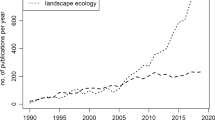
Overview
- Presenting the first large overview of this emerging perspective in agronomy
- Exploring the cutting-edge of data availability and processing methods
- Tests a theoretical framework for scientists to support policy and decision makers
Access this book
Tax calculation will be finalised at checkout
Other ways to access
About this book
This book covers the background that improved the transdisciplinary interface of agronomy with spatially-explicit disciplines like landscape ecology and geography both in research and in training programs, in addition to some experiences of participative landscape management. On these bases, the state of art on cutting-edge data availability and methodological issues is used to select and discuss some worldwide case studies.
This selection of research topic examples underpins the concluding discussions about challenges ahead. Researchers as well as policy and decision makers are the main target of this book that seeks to provide a toolbox of concepts, examples and ideas to improve the understanding of agricultural landscapes. Agricultural activities manage the greatest share of land surface on Earth with fast-paced changes compared to any other human land use. With this book we aim at providing a stronger interface between agricultural science and landscape design processes.
Similar content being viewed by others
Keywords
Table of contents (10 chapters)
-
Front Matter
-
Supporting Action
-
Front Matter
-
Editors and Affiliations
About the editors
Elisa Marraccini is an associate professor in Agronomy and Crop Science at the University of Udine, Italy. Her main research interests are the design and assessment of sustainable cropping and farming systems in different contexts and the understanding of the land use trajectories at the farm, landscape and regional levels.
Sylvie Lardon is a senior scientist at INRAE and associated professor at AgroParisTech, at Clermont-Ferrand, France. Her research focuses mainly on the development and use of qualitative spatial models to build shared visions and improve actors’ participation in territorial projects.
Bibliographic Information
Book Title: Landscape Agronomy
Book Subtitle: Advances and Challenges of a Territorial Approach to Agricultural Issues
Editors: Davide Rizzo, Elisa Marraccini, Sylvie Lardon
DOI: https://doi.org/10.1007/978-3-031-05263-7
Publisher: Springer Cham
eBook Packages: Biomedical and Life Sciences, Biomedical and Life Sciences (R0)
Copyright Information: Springer Nature Switzerland AG 2022
Hardcover ISBN: 978-3-031-05261-3Published: 10 September 2022
eBook ISBN: 978-3-031-05263-7Published: 09 September 2022
Edition Number: 1
Number of Pages: XIX, 294
Number of Illustrations: 14 b/w illustrations, 41 illustrations in colour
Topics: Agriculture, Landscape Ecology, Environmental Management, Sustainable Development, Landscape/Regional and Urban Planning


